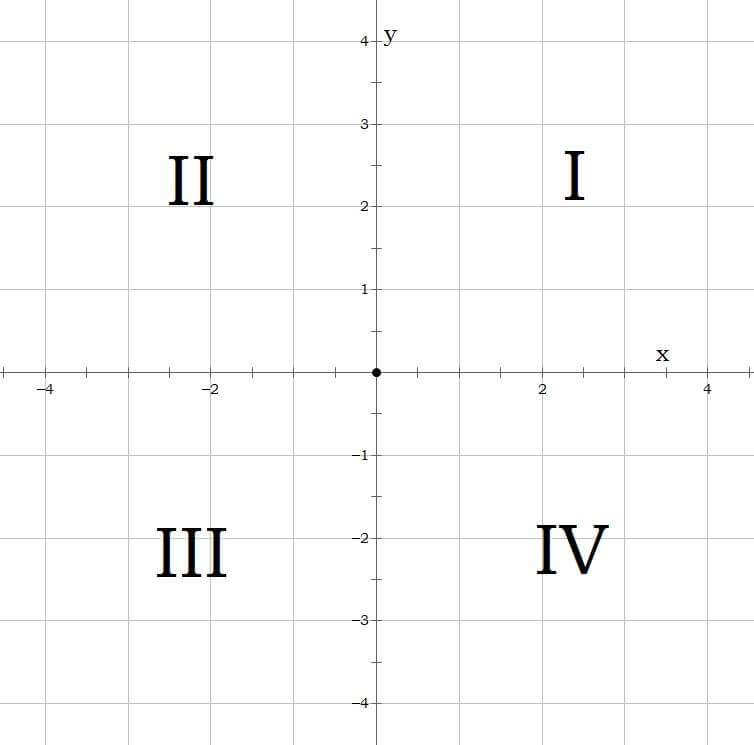All Algebra II Resources
Example Questions
Example Question #5 : Inequalities
Set up the inequality expressed in the word problem below:
Elise went to the grocery store, and bought a bunch of sweet potatoes and onions. She knows she has less than 12 altogether. What is the inequality that expresses how many sweet potatoes (x) and onions (y) she could have bought?

Example Question #1 : Setting Up Inequalities
If 


Quadrant III
Quadrant I
Quadrant IV
Quadrant II
The point will land on the x or y axis, therefore there is no quadrant for the scenario.
Quadrant IV

Because x is greater than zero, it will be to the right of the y axis. Because y is less than zero, it will be below the x axis. This is the fourth quadrant.
Example Question #1 : Setting Up Inequalities
At a fair, there is a game where players step on a scale and weigh themselves. The objective of the game is for the host to guess the player's weight. A player loses if the host of the game can guess the player's weight within 


For the player to lose, the host has to guess within 







Example Question #8 : Inequalities
Set up the following inequality: Four less than three times a number squared is at least six.
Split up the inequality into parts.
A number squared:
Three times a number squared:
Four less than three times a number squared:
Is at least six:
Combine all the parts to form an inequality:
The answer is:
Example Question #9 : Inequalities
Set up the inequality: Four times the quantity of a number less than five is more than six.
Break up the sentence into parts.
A number less than five:
The quantity of a number less than five:
Four times the quantity of a number less than five:
More than six:
Combine the terms.
The answer is:
Example Question #203 : Basic Single Variable Algebra
Set up the inequality: Four times the quantity of two less than three times a number is at most ten.
Break up the inequality into parts.
Three times a number:
Two less than three times a number:
The quantity of two less than three times a number:
Four times the quantity of two less than three times a number:
Is at most ten:
Combine the terms to form the inequality.
The answer is:
Example Question #204 : Basic Single Variable Algebra
Set up the following inequality: The product of two and the quantity of two less than five times a number must exceed twelve.
Split up the inequality into parts.
Five times a number:
Two less than five times a number:
The quantity of two less than five times a number:
The product of two and the quantity of two less than five times a number:
Must exceed twelve:
The answer is:
Example Question #205 : Basic Single Variable Algebra
Set up the inequality: Twice the quantity of three less than twice a number must be more than ten.
Break up the sentence into parts. Start with the inner quantity.
Twice a number:
Three less than twice a number:
The quantity of three less than twice a number:
Twice the quantity of three less than twice a number:
Must be more than ten:
Combine the terms to write the inequality:
The answer is:
Example Question #206 : Basic Single Variable Algebra
Set up the inequality: Four less than six times the square root of a number is at least five.
Break up the statement into parts.
The square root of a number:
Six times the square root of a number:
Four less than six times the square root of a number:
At least five:
Combine the parts to form the inequality.
The answer is:
Example Question #207 : Basic Single Variable Algebra
Set up the inequality: Five more than eight times a number must exceed fourteen.
Separate the sentence into parts and let the unknown number be 
Eight times a number:
Five more than eight times a number:
Must exceed fourteen:
Combine the parts to form the inequality.
The answer is:
All Algebra II Resources












































![2[5(x-2)]>12](https://vt-vtwa-assets.varsitytutors.com/vt-vtwa/uploads/formula_image/image/745993/gif.latex)










![2[2(x-3)]>10](https://vt-vtwa-assets.varsitytutors.com/vt-vtwa/uploads/formula_image/image/762991/gif.latex)































